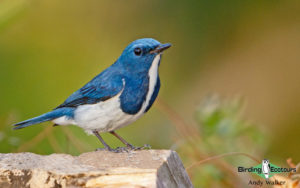Go to Northern Thailand bird tour page | Thailand bird tours | Asian trip reports | All our birding tours
DOWNLOAD TRIP REPORT
16-26 JANUARY 2020
By Andy Walker
The views we had of Ultramarine Flycatcher were exceptional; this is one stunning bird!
Overview
This ten-day set departure birdwatching tour of Northern Thailand commenced in Chiang Mai on the 16th of January 2020 and ended back there on the 26th of January 2020. This tour visited Doi Inthanon National Park, Mae Ping National Park, Chiang Dao Wildlife Sanctuary, Doi Pha Hom Pok National Park (Doi Ang Khang and Doi Lang sections), the Thaton and Chiang Dao rice paddies, Doi Tung (Mae Fah Luang Arboretum), and Chiang Saen Lake and surroundings.
A total of 299 bird species were seen (plus eight species heard only), set in some remarkable scenery. Full species lists are provided at the end of this report.
Resident and migrant bird highlights were many across the range of sites visited and included seeing Green Peafowl, Mrs. Hume’s Pheasant, Spot-breasted and Grey-headed Parrotbills, Siberian Rubythroat, Ultramarine Flycatcher, Pied Harrier, White-crowned Forktail, Rufous-throated Partridge, Himalayan Shortwing, Spectacled Barwing, Black-headed and White-bellied Woodpeckers, Blossom-headed and Grey-headed Parakeets, Burmese Nuthatch, Giant Nuthatch, White-gorgeted Flycatcher, Rufous-gorgeted Flycatcher, Himalayan Cutia, Scarlet-faced Liocichla, Silver-eared Mesia, Crested Finchbill, Striated Bulbul, Daurian Redstart, Blue-fronted Redstart, White-bellied Redstart, White-capped Redstart, and Small Pratincole. Thrushes were very well represented this year, and we found Scaly Thrush, Dark-sided Thrush, Grey-winged Blackbird, Chestnut Thrush, Eyebrowed Thrush, Grey-sided Thrush, and Black-breasted Thrush along with many other species giving excellent photographic opportunities.
Detailed Report
Day 1, 16th January 2020. Arrival in Chiang Mai
The group arrived in Chiang Mai and gathered for a welcome meal ahead of the birding to start the following day.
Day 2, 17th January 2020. Doi Inthanon National Park
We left the city after breakfast and made our way straight to Doi Inthanon National Park and the summit area. The unique habitat found here is home to a number of special birds, and we enjoyed plenty of good views of them during the morning. One of the first birds, and one of the best, was Himalayan Shortwing. This species is usually highly skulking, but this individual gave great views right out in the open! We also saw a couple of spectacular White-crowned Forktails, Green-tailed Sunbird (an endemic subspecies found only at Doi Inthanon), Rufous-throated Partridge, Silver-eared Laughingthrush, Mrs. Gould’s Sunbird, Bar-throated Minla, Rufous-winged Fulvetta, Dark-backed Sibia, Blue Whistling Thrush (migratory subspecies), Davison’s Leaf Warbler, Ashy-throated Warbler, and Blyth’s Leaf Warbler.
After lunch we called in at a bird hide (blind), where we were greeted with excellent views of some secretive species such as (another) White-crowned Forktail, the very showy Pygmy Cupwing, Siberian Blue Robin, Hill Blue Flycatcher, Taiga Flycatcher, Rufous-bellied Niltava, and Plumbeous Water Redstart.
In the late afternoon we walked a forest trail and found Spectacled Barwing, Yellow-bellied Fantail, Yellow-cheeked Tit, Blyth’s Shrike-babbler, Blue-winged Minla, Davison’s Leaf Warbler, and Chestnut-vented Nuthatch along with plenty of other birds to end a great first day in the country.
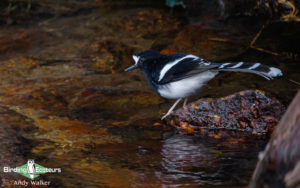
Day 3, 18th January 2020. Doi Inthanon National Park
We spent all morning birding an excellent forest trail in the national park. Birds came thick and fast at times, and we found some awesome species, including Green Cochoa, Yellow-bellied Flowerpecker, Maroon Oriole, Wedge-tailed Green Pigeon, Hill Prinia, Bay Woodpecker, Speckled Piculet, Vivid Niltava, Large Niltava, Yunnan Fulvetta, Little Pied Flycatcher, Mountain Bulbul, White-throated Fantail, Yellow-cheeked Tit, Japanese Tit, Grey-backed Shrike, and Lesser Racket-tailed Drongo, as well as many other birds seen the previous day.
In the afternoon we took another trip around the summit, where we had great views of Mrs. Gould’s and Green-tailed Sunbirds, a covey of Rufous-throated Partridge, and White-crowned Forktail again.
A couple of stops along the way down the mountain produced the stunning White-capped Redstart, Slaty-backed Forktail, Grey Wagtail, and Blue Whistling Thrush (resident subspecies).
Day 4, 19th January 2020. Doi Inthanon National Park and Mae Ping National Park
We started the morning waiting for Blossom-headed Parakeets to leave their roost site and drop in and give us a view, and that they did, stunning birds! However, before that one of the surprises of the whole tour occurred when we noticed a small flock of the Endangered (BirdLife International) Green Peafowl roosting in some nearby trees while it was still dark. As it got a bit lighter we could make out a bit more of the birds and grabbed a couple of record shots of this rare bird. One other spectacular sight involved a flock of around 150 Green Bee-eaters that left their nearby roost site and sat in a bare tree, giving some nice views as they huddled together for warmth as the sun rose. Still more birds came into view, such as Burmese Shrike, Golden-fronted Leafbird, Purple Sunbird, Red-whiskered Bulbul, Chestnut-tailed Starling, and Pied Bush Chat.
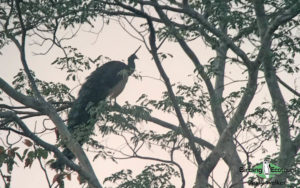
After enjoying all these birds we moved back into the national park, where we found several different species, such as Silver-eared Mesia, White-bellied Erpornis, Puff-throated Bulbul, Grey-eyed Bulbul, Green-billed Malkoha, Scarlet Minivet, Blue-winged Leafbird, and a brief Slaty-bellied Tesia.
Once we’d had lunch we moved south to Mae Ping National Park, where a short walk before dusk gave us more new birds; some of these included White-bellied Woodpecker, Ultramarine Flycatcher, Grey-headed Parakeet, Large Cuckooshrike, Black-naped Monarch, and Velvet-fronted Nuthatch.
Day 5, 20th January 2020. Mae Ping National Park to Chiang Dao
We spent the morning birding in Mae Ping National Park, where we found many great birds. Some of the best of these included Grey-headed Parakeet, Black-headed Woodpecker, Burmese Nuthatch, Collared Falconet, Grey-capped Pygmy Woodpecker, Great Barbet, Red-billed Blue Magpie, Rufous Treepie, and White-crested Laughingthrush, along with Black-hooded Oriole, Black-naped Oriole, Velvet-fronted Nuthatch, Short-billed Minivet, Burmese Shrike, Common Flameback, Greater Flameback, and Olive-backed Sunbird.
The majority of the afternoon was spent traveling up to Chiang Dao, where we checked into our accommodation for the next couple of nights, ready to explore the local area.
Day 6, 21st January 2020. Doi Chiang Dao Wildlife Sanctuary
We set off early from our accommodation to reach the top of Doi Chiang Dao for first light, and as soon as we stepped out of the vehicle at the clearing the birds started coming thick and fast. A fruiting tree was really attracting birds such as Slender-billed Oriole, Blue-eared Barbet, Mountain Bulbul, and Black Bulbul (as well as several other species of bulbuls). Mountain Imperial Pigeon, Cook’s Swift, Asian House Martin, and Striated Swallow were passing overhead. Grey Treepie, Great Barbet, Black-winged Cuckooshrike, Verditer Flycatcher, and Long-tailed Minivet were moving around the periphery of the clearing. Olive-backed Pipits, Chestnut Buntings, and Common Rosefinches were leaving their nearby roost sites, some perching to give good views. All hell broke loose when a Collared Owlet flew in, presumably looking for breakfast, and most of the birds feeding in the fruit tree started mobbing it, along with Streaked Spiderhunter and Grey-backed Shrike. The owl gave great views before eventually moving on.
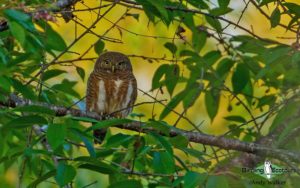
A hike along a trail gave some incredible views of the spectacular landscape, and we picked up several tough birds along the way, such as Grey-headed Parrotbill, Aberrant Bush Warbler, Rufous-fronted Babbler, Grey-crowned Warbler, and more Grey Treepies. Velvet-fronted Nuthatches were noted, as too were Bay and Stripe-breasted Woodpecker, Little Pied Flycatcher, and Pale Blue Flycatcher.
As we drove down the mountain a brief stop yielded Eurasian Jay, Greater Necklaced Laughingthrush, and Yunnan Fulvetta, and then a quick session around nearby rice paddies provided lots of new trip birds. Some of the highlights included Glossy Ibis (rare in the north of the country), Grey-headed Lapwing, Wire-tailed Swallow, Long-tailed, Brown, and Grey-backed Shrikes, Stejneger’s Stonechat, Eastern Yellow Wagtail, White Wagtail, Pied Bush Chat, Black-collared Starling, Pied Myna, Greater Painted-snipe, Common Snipe, and Pin-tailed Snipe.
Day 7, 22nd January 2020. Doi Chiang Dao Wildlife Sanctuary and Thaton arable land
We spent the morning birding near our accommodation in the Doi Chiang Dao Wildlife Sanctuary and found some really nice birds; some of these were Pin-tailed Green Pigeon, Violet Cuckoo, Yellow-bellied Warbler, Little Spiderhunter, Purple-naped Sunbird, Crimson Sunbird, Black-hooded Oriole, Black Bulbul, Streaked Wren-Babbler, Thick-billed Flowerpecker, Hill Blue Flycatcher, and Asian Fairy-bluebird.
Some of the highlights from the afternoon birding in some arable land included Small Pratincole, Chestnut-capped Babbler, Yellow-eyed Babbler, Bluethroat, Eurasian Hoopoe, Richard’s Pipit, Paddyfield Pipit, Little Ringed Plover, Temminck’s Stint, Green Sandpiper, and Long-tailed Shrike.
Day 8, 23rd January 2020. Doi Pha Hom Pok National Park: Doi Ang Khang
This was an exciting day birding in the mountains around Doi Ang Khang. We arrived at dawn and watched a fantastic sunrise while we ate our picnic breakfast. As the sun started warming up the bird activity started with Giant Nuthatch calling away, followed by a wave of birds such as Chestnut, Black-breasted, and Eyebrowed Thrushes, Chestnut-vented Nuthatch, and Grey-capped Pygmy Woodpecker. Walking along the forest edge we found a fruiting tree that contained several great birds, including Striated Bulbul, Crested Finchbill, Brown-breasted Bulbul, Speckled Piculet, Long-tailed Minivet, Rufous-bellied Niltava, Japanese Tit, and Golden-throated Barbet, which all gave fantastic views. As we checked out some grassland we found Spot-breasted Parrotbill, Silver-eared Laughingthrush, Yellow-streaked Warbler, Silver-eared Mesia, Yunnan Fulvetta, Blue-winged Minla, and Scarlet-faced Liocichla. Mountain Hawk-Eagle, Crested Honey Buzzard, and Cook’s Swift were overhead (and later we added Peregrine Falcon to our day list too).
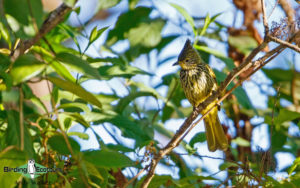
From late-morning until mid-afternoon we moved locations around the mountain and found a host of new birds as well as more of the above; some of the top picks included White-tailed Robin, Dark-sided Thrush, numerous Black-breasted Thrushes (some giving extremely good, close views), Daurian Redstart, Blue-throated Barbet, Mrs. Gould’s Sunbird, Olive-backed Pipit, and Orange-breasted Leafbird, to name a few (along with numerous Phylloscopus warblers and several white-eyes).
As we drove off the mountain in the evening we found a huge flock of Asian House Martins, which also contained Himalayan Swiftlet and Dusky Crag Martin.
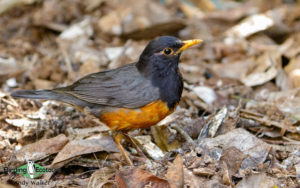
Day 9, 24th January 2020. Doi Pha Hom Pok National Park: Doi Lang west
Another full day birding in Doi Pha Hom Pok National Park, this time in the Doi Lang (west) section. Our first stop was along the entrance road, where we sat in wait as the sun rose. Several birds came into view at first light and included Rusty-cheeked Scimitar Babbler, White-browed Laughingthrush, Oriental Turtle Dove, Grey Bush Chat, Japanese Tit, and Giant Nuthatch. These were all great, but the star bird was just about to come into view. All of a sudden three Mrs. Hume’s Pheasants flew across the road and then walked into view, where they showed well.
We spent the majority of the day checking out bird feeding stations and sections of forest, where we found a huge range of birds, many of them extremely confiding, showing exceptionally well, and posing for photos. Some of the highlights during the day included Himalayan Cutia, Sapphire Flycatcher, Slaty-backed Flycatcher, Siberian Rubythroat, White-bellied Redstart, Black-throated Bushtit, Spectacled Barwing, White-browed Scimitar Babbler, Silver-eared Laughingthrush, Rufous-bellied Niltava, Yellow-cheeked Tit, Dark-backed Sibia, Rufous-backed Sibia, Rufous-gorgeted Flycatcher, White-gorgeted Flycatcher, and Chestnut Bunting.
Our last stop of the day gave us some spectacular views of an adult male Ultramarine Flycatcher in the gorgeous evening light (see trip report cover image), with a cloud of Cook’s Swifts flying overhead. A great way to end the day’s mountain birding!
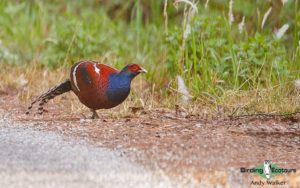
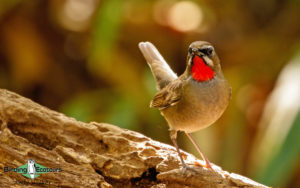
Day 10, 25th January 2020. Doi Tung – Mae Fah Luang Arboretum and Chiang Saen Lake
The morning was spent in the beautiful gardens at Mae Fah Luang, where we had a bit of a thrush bonanza that included Chestnut Thrush, Grey-winged Blackbird, Grey-sided Thrush, and Eyebrowed Thrush, along with several other good birds such as Slaty-backed Flycatcher, Rufous-gorgeted Flycatcher, and Blue Whistling Thrush (resident and migratory subspecies).
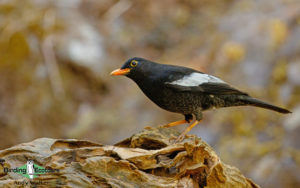
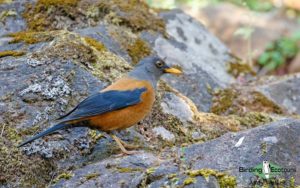
Also present in the beautiful gardens were Grey-backed Shrike, White-rumped Shama, Olive-backed Pipit, Chestnut Bunting, Slaty-backed Flycatcher, Rufous-gorgeted Flycatcher, Lesser Coucal, and Blue-fronted Redstart. An excellent way to end our mountain birding of the tour!
Our final afternoon birding session was spent around Chiang Saen Lake, where we found several new species for the tour. Some of the highlights were Ruddy Shelduck, Indian Spot-billed Duck, Ferruginous Duck, Pheasant-tailed Jacana, Grey-headed Swamphen, Great Egret, Purple Heron, Plaintive Cuckoo, Greater Coucal, Lesser Coucal, and Eurasian Wryneck.
The final birding session of the day was at a hide where we got some incredible, close views of Pied Harriers and Eastern Marsh Harriers as they came in to roost. A spectacular end to the day! We had our final group evening meal of the tour and reflected on what had been a great trip.
Day 11, 26th January 2020. Chiang Saen Lake and Chiang Mai
We had a final morning birding session back at Chiang Saen Lake, where we picked up a few new trip birds and improved views of some others. The water was practically devoid of birds for some reason, which was a shame, although we did find a group of Ruddy Shelducks, which looked beautiful in the morning light. A large flock of hirundines contained Common House Martin (eastern subspecies and potential future split), Asian House Martin, Grey-throated Martin, Red-rumped Swallow, Barn Swallow, and Striated Swallow, as well as House Swift, Asian Palm Swift, and Glossy Swiftlet. We had further views of Pied Harrier and Eastern Marsh Harrier, the latter flying really close to us and giving great views. We also improved our views of Striated Grassbird and a few other species, such as Black-headed Bulbul, Scarlet-backed Flowerpecker, Thick-billed and Dusky Warblers, Green Bee-eater, and Racket-tailed Treepie. It was also interesting to hear Burmese Shrike singing.
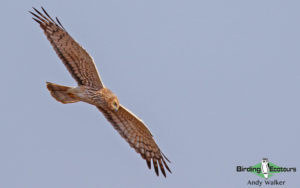
Before too long it was time to jump into the van and drive back to Chiang Mai, where the tour ended.
In the vehicle on the way to Chiang Mai there was a discussion on ‘Bird of the Trip’, but with so many incredible views of some amazing birds it was tough to come up with a clear favorite. Some of the top choices therefore included: Mrs. Hume’s Pheasant, Himalayan Cutia, Siberian Rubythroat, Collared Owlet, Spot-breasted Parrotbill, Pied Harrier, and Ultramarine Flycatcher, based on a mix of desirability, rarity, prettiness, and outstanding views.
Please see the downloadable PDF above with the full species lists included.
